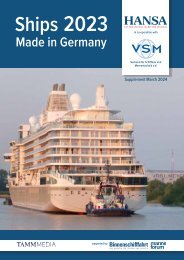HANSA 01-2021
Hull Performance & Coating · Svitzer · Yacht »Soaring« · Schifffahrtsaktien & Börsen · Harren & Partner · LNG in der Schulte-Gruppe · Berenberg Bank · Schiffsinspektionen
Hull Performance & Coating · Svitzer · Yacht »Soaring« · Schifffahrtsaktien & Börsen · Harren & Partner · LNG in der Schulte-Gruppe · Berenberg Bank · Schiffsinspektionen
Erfolgreiche ePaper selbst erstellen
Machen Sie aus Ihren PDF Publikationen ein blätterbares Flipbook mit unserer einzigartigen Google optimierten e-Paper Software.
SCHiFFStECHNiK | SHiP tECHNoloGY<br />
Data to hand<br />
This aggregation error can be reduced<br />
by more frequent reporting. auto-logging<br />
fuel consumption and speed is one<br />
option. But retrofitting such systems<br />
is expensive and for existing vessel the<br />
business case is usually weak. another<br />
option is reading and reporting consumption<br />
on each significant speed or<br />
weather change. This is unlikely to be<br />
practical for crew.<br />
The problem can however be overcome<br />
by exploiting sensors and systems already<br />
present on all vessels. While recording<br />
high-frequency fuel flow data is expensive,<br />
other data – including position,<br />
speed through water and wind - is usually<br />
available through the vessel’s ECdiS at<br />
high frequency and low cost. often rPM<br />
is available through NMEa. and speed<br />
through water can be substituted by speed<br />
over ground (from GPS positions) when<br />
combined with current hindcast data.<br />
in a previous paper, Wärtsilä Voyage<br />
presented a sensor fusion model that used<br />
speed over ground, forecast data, and fuel<br />
consumption from noon reporting to create<br />
a »virtual flow meter«. This model,<br />
known as the Fuel Flow Model (FFM),<br />
was verified and it proved to be capable<br />
of removing the aggregation error from<br />
pure noon data.<br />
The FFM is a »grey box« model. While<br />
a black box model would purely use data<br />
to »learn« the relationships of various inputs<br />
such as speed and weather to fuel consumption,<br />
a white box model is powered by<br />
standardized formulas that include coeffcients<br />
depending on vessel characteristics.<br />
one problem with the white box is<br />
that it cannot account for vessel specifics<br />
such as hull fouling over time. Conversely,<br />
black box models are unable to<br />
predict outcomes in operational conditions,<br />
which have not been covered in<br />
the training data if e.g., weather or operational<br />
profile change to completely new<br />
conditions, this makes black box model<br />
predictions unreliable.<br />
as a grey box model, FFM combines the<br />
robustness of a white box approach with<br />
the data driven vessel specifics tuning of<br />
a black box model. input data includes<br />
high-frequency readings of speed over<br />
ground, heading, depth, etc. (through<br />
ECdiS), different hindcast databases for<br />
weather parameters, and draft and fuel<br />
consumption measurements from noon<br />
reports. The FFM is upsampling the noon<br />
aggregated data (containing aggregation<br />
error) to high frequency data (without aggregation<br />
error)<br />
Testing the model<br />
Hull performance is a major aspect for ship owners and managers<br />
a numerical study was used to verify<br />
FFM. This involves generating realistic,<br />
high-frequency draft and speed readings<br />
and then computing consumption for a<br />
generic test vessel using a simplified formula<br />
based on speed, draft and other vessel<br />
characteristics. The model was then<br />
applied to consumption data aggregated<br />
to noon periods as well as speed and draft.<br />
The modelled high frequency consumption<br />
output was compared to the<br />
original generic input data. The accordance<br />
of the model output with the<br />
»true« data was shown to be very close<br />
after a short learning period, indicating<br />
that FFM can predict high frequency<br />
(flow meter like) fuel flow which is free<br />
from the aggregation error.<br />
in a second phase of testing, FFM was<br />
also able to remove large parts of error<br />
added to the input data, representing potential<br />
human error when inputting noon<br />
report data. This proved that the model is<br />
robust enough to remove significant error<br />
from the noon report data.<br />
in real life, the performance of the vessel<br />
changes over time due to hull fouling. This<br />
needs to be accounted for by the modelling,<br />
adjusting vessel coeffcients as performance<br />
changes. in the third phase of testing<br />
the model was exposed to generic data<br />
for a vessel with performance changing in<br />
time. Six scenarios were tested, including<br />
three with added (human noon reporting)<br />
errors. The model was able to predict the<br />
performance change well in all scenarios.<br />
Outlook<br />
The fuel readings performed by the crew<br />
on a noon-to-noon basis are usually imprecise<br />
due to human error. Furthermore,<br />
speed consumption analysis based on<br />
noon aggregated data suffers from systematical<br />
statistical error. The Fuel Flow Model<br />
has been proved to be able to remove both<br />
types of errors. Thus, it provides a practical<br />
approach to hull performance prediction<br />
that can be applied on any vessel. The<br />
Fuel Flow Model presented here is a simpler<br />
version of the one underlying Wärtsilä<br />
Voyage’s Fleet operations Solution. in<br />
a business setting this approach has proved<br />
to be robust and reliable. it is being used to<br />
predict hull fouling and to check the quality<br />
of fuel consumption reporting.<br />
authors: Daniel Schmode,<br />
Head of Solution advisory<br />
Matti Antola, data Scientist<br />
Wärtsilä Voyage<br />
© HaNSa archive<br />
HaNSa – international Maritime Journal <strong>01</strong> | <strong>2021</strong><br />
49


















